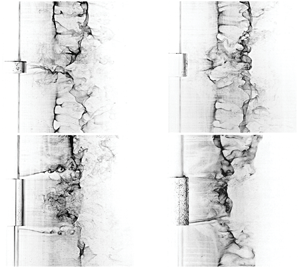Article contents
Vortex shedding from cylinders with two step discontinuities in diameter
Published online by Cambridge University Press: 14 September 2020
Abstract

A dual-step cylinder is a canonical geometry commonly encountered in many practical flows. It consists of a large diameter cylinder ( $D$) attached coaxially to the mid-span of a small diameter cylinder (
$D$) attached coaxially to the mid-span of a small diameter cylinder ( $d$). This work provides a comprehensive description of the flow development, classifies common wake regimes and considers the associated structural loading on a dual-step cylinder. The influence of the aspect ratio of the large diameter cylinder (
$d$). This work provides a comprehensive description of the flow development, classifies common wake regimes and considers the associated structural loading on a dual-step cylinder. The influence of the aspect ratio of the large diameter cylinder ( $L/D$) and diameter ratio (
$L/D$) and diameter ratio ( $D/d$) is studied experimentally for a Reynolds number of
$D/d$) is studied experimentally for a Reynolds number of  $Re_D = 2100$,
$Re_D = 2100$,  $1.33\leq D/d \leq 4$ and
$1.33\leq D/d \leq 4$ and  $0.2\leq L/D \leq 5$. The flow evolution and structural loading are quantified via a combination of flow visualization, Laser Doppler velocimetry, particle image velocimetry measurements and multi-component force balance measurements. Through a detailed analysis of the results, six distinct flow regimes are identified based on observed changes in the flow development downstream of the large diameter cylinder. The findings are distilled into a map of flow regimes that provides a framework for analysis of the dual-step cylinder wakes and incorporates limiting cases of this geometry, namely, uniform circular cylinders, cantilevered cylinders, cylinders with two free ends, coin-like cylinders and single-step cylinders. The identified flow regimes are also related to changes in structural loading.
$0.2\leq L/D \leq 5$. The flow evolution and structural loading are quantified via a combination of flow visualization, Laser Doppler velocimetry, particle image velocimetry measurements and multi-component force balance measurements. Through a detailed analysis of the results, six distinct flow regimes are identified based on observed changes in the flow development downstream of the large diameter cylinder. The findings are distilled into a map of flow regimes that provides a framework for analysis of the dual-step cylinder wakes and incorporates limiting cases of this geometry, namely, uniform circular cylinders, cantilevered cylinders, cylinders with two free ends, coin-like cylinders and single-step cylinders. The identified flow regimes are also related to changes in structural loading.
JFM classification
- Type
- JFM Papers
- Information
- Copyright
- © The Author(s), 2020. Published by Cambridge University Press
References
REFERENCES
Morton and Yarusevych supplementary movie
Hydrogen bubble flow visualization of shear layer instabilities within the IS regime for a dual step cylinder at ReD = 2100, D=d = 2:67, and L=D = 3.
Morton and Yarusevych supplementary movie
- 11
- Cited by





